Applications in control systems |
Air safety dampers - Air control dampers - Fire/smoke dampers |
Air damper control
|
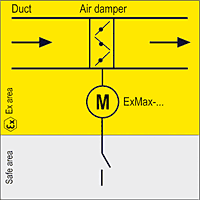 |
Schischek actuators are approved for direct installation and operation in explosive atmospheres, as they are of the highest explosion groups and temperature class and are suitable for all gases, mists, vapors and dust. During installation please ensure that all cables are securely fixed and connected in such a way that they are protected from mechanical damage. For electrical connection an explosion protected terminal box (type ExBox-...) has to be used.
|
Automatic air damper control
|
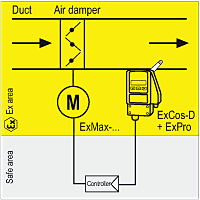 |
In this example the control system consists of an actuator and an ExCos-D transmitter with ExPro sensor. The combination can be installed directly in an Ex area. The transmitter converts the sensor signal into an active signal (0...10 VDC or 4...20 mA) for input in a PLC system. The output signal from the controller goes directly to the actuator. Between sensor and control-
ler an additional Ex-i module and intrinsically safe (IS) circuit wiring are not required. For the actuator and transmitter the maximum permissible surface tempe-
ratures have to be taken into account.
|
Control of fire and smoke dampers
|
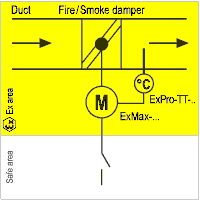 |
In applications for fire/smoke dampers, the actuator has to reliably return the damper to its safety position via an external switch/contact. The actuator closes the damper mechanically by means of an internal spring. The closing operation is triggered by a safety thermal trigger of type ExPro-TT-...
|
Heating - Cooling - Humidification - VAV control |
Heating - Cooling control
|
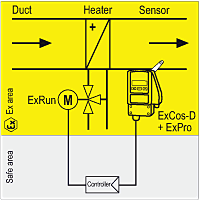 |
In this example the control system consists of an actuator and an ExCos-D transmitter with ExPro sensor. The combination can be installed directly into an Ex area. The transmitter converts the sensor signal into an active signal (0...10 VDC or 4...20 mA) for input in a PLC system.
The output signal from the controller goes directly to the actuator. Between sensor and control-
ler an additional Ex-i module and intrinsically safe (IS) circuit wiring are not required. For the actuator and transmitter the maximum permissible surface tempe-
ratures have to be taken into account.
|
Humidity control
|
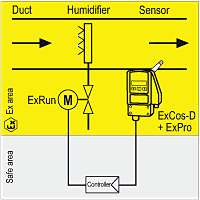 |
In this example the control system consists of a valve actuator and an ExCos-D trans-
ducer with ExPro sensor.
The combination can be installed directly into an Ex area. The transmitter converts the sensor signal into an active signal (0...10 VDC or 4...20 mA) for input in a PLC system.
The output signal from the controller goes directly to the actuator. Between sensor and control-
ler an additional Ex-i module and intrinsically safe (IS) circuit wiring are not required. For the actuator and transmitter the maximum permissible surface tempe-
ratures have to be taken into account.
|
VAV and differencial pressure control
|
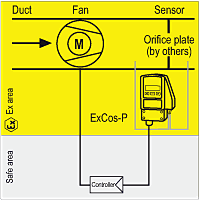 |
In this example the control system consists of an actuator and a differential pressure ExCos-P transmitter. The combination can be installed directly in an Ex area. The transmitter converts the differential pres-
sure signal into an active signal (0...10 VDC or 4...20 mA) for input in a PLC sys-
tem. The output signal from the controller goes directly to the actuator. Between sensor and controller an additional Ex-i module and intrinsically safe (IS) circuit wiring are not required. The controller is located in the safe area and delivers an output signal for example via a frequency converter to control a fan (must be Ex protected) or a modulating damper actuator (also Ex protected) to maintain the required air volume/pressure.
The technical specifications can be found in the approval documents.
|
Thermostats - Humidistats - Pressostats - Filter protection |
Thermostat (binary sensor for temperature °C)
|
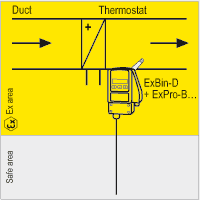 |
ExBin-D... modules with ExPro-BT... sensor are thermostats for use in potentially explosive atmospheres. No intrinsically-
safe electrical circuits and no switching amplifiers need to be installed in the electrical control-panel. The module may be installed directly in an Ex area, depending on demand in zone 1, 2, 21 or 22. The output contact can be used for follow-up functions (relays, contacts, direct circuit, ...).
|
Hygrostat (binary sensor for humidity %rH)
|
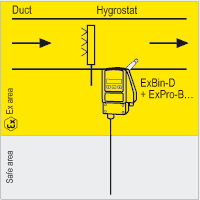 |
ExBin-D... modules with ExPro-BF... sensor are hygrostats for use in potentially explosive atmospheres. No intrinsically-
safe electrical circuits and no switching amplifiers need to be installed in the electrical control-panel. The module may be installed directly in an Ex area, depending on demand in zone 1, 2, 21 or 22. The output contact can be used for follow-up functions (relays, contacts, direct circuit, ...).
|
Filter monitoring with differential pressure switch
|
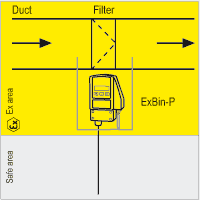 |
ExBin-P... modules are pressostats like Ex-differential pressure switches, e.g. for filter monitoring in potentially explosive atmospheres. No intrinsically-safe electrical circuits and no switching amplifiers need to be installed in the electrical control-panel. The module may be installed directly in an Ex area, depending on demand in zone 1, 2, 21 or 22. The output contact can be used for follow-up functions (relays, contacts, direct circuit, ...).
|
Drive (Fan) belt monitoring - Frost protection |
Drive (Fan) belt monitoring with differential pressure sensor/air paddle
|
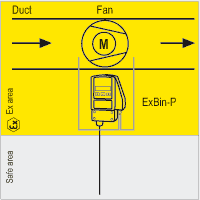 |
ExBin-P... modules are pressostats like Ex-differential pressure switches, e.g. for fan belt monitoring in potentially explosive atmospheres. No intrinsically-safe electrical circuits and no switching amplifiers need to be installed in the electrical control-panel. The module may be installed directly in an Ex area, depending on demand in zone 1, 2, 21 or 22. To indicate fan failure switching modules are delivered with integrated time running relay with delay on start up.
The output contact can be used for follow-
up functions (relays, contacts, direct circuit, ...).
|
Drive (Fan) belt monitoring with inductive Namur sensor
|
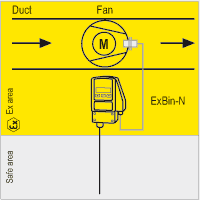 |
ExBin-N... modules with connected Namur sensor (inductive proximity switch) are especially for contact-free fan belt monitoring of ventilators, for use in potentially explosive atmospheres.
No intrinsically-safe electrical circuits and no switching amplifiers need to be installed in the electrical control-panel. The module may be installed directly in an Ex area, depending on demand in zone 1, 2, 21 or 22. To indicate fan failure switching modules are delivered with integrated time running relay with delay on start up.
The output contact can be used for follow-
up functions (relays, contacts, direct circuit, ...).
|
Frost protection monitoring over binary sensor with capillary
|
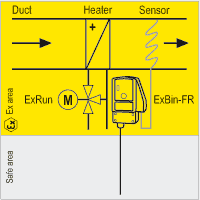 |
ExBin-FR... are sensors for frost protection monitoring with a capillary as measuring element for use in potentially explosive atmospheres. No intrinsically-safe electrical circuits and no switching amplifiers need to be installed in the electrical control-panel. The module may be installed directly in an Ex area, depending on demand in zone 1, 2, 21 or 22. The output contact can be used for follow-up functions (relays, contacts, direct circuit, ...).
|
Correct installation
For the installation of electrical systems in areas with explosive atmospheres of group II, standards IEC 60 079-14 (EN 60079-14) or VDE 0165 apply. In Germany however solely the Technical Rules for Occupational Safety grant the presumption of conformity!
Electric circuits of protection types d, e, q, o, m, p
Installation in the control panel is identical to "standard" installation, however the procedures for connecting Ex equipment must be followed. This relates, for example to voltage, current, fuses and motor protection equipment, etc. The requirements for specific products need to be taken from their corresponding test certificates, standards and regulations as well as from the user manual. It is only permitted to work on electric circuits within the Ex-area (for example when making connections in an Ex-e terminal box) when the voltage has been switched off. An Ex-e terminal box should only be opened after the voltage has been switched off.
Electric circuits of protection type „i“ (intrinsic safety)
For the planning and operation of switchgears and control systems installed in the safe area, but which contain circuits leading into the Ex-area, certain requirements need to be considered. This applies especially to intrinsically safe circuits. Intrinsically safe circuits and non-intrinsically safe circuits need to be separated. Minimum distances (tight string length) between bare connections must be observed, the cables must not produce any inadmissible external inductance or capacitance. The maximum admissible electrical limits of Ex-i equipment must be observed at all times. Intrinsically safe and non-intrinsically
safe electrical circuits may not be connected together. Connections between
two different intrinsically-safe circuits are permitted on the condition that a calculation shows that intrinsic safety is not compromised.
Intrinsically-safe circuits have to be marked as such. When marking is done by means of colors, "light blue" color has to be used. This colour is recommended for all intrinsically safe circuits to prevent confusion and/or connection to a non-intrinsically safe circuit. Examples: cables, wiring, cable conduits, terminals, terminal boxes, cable glands ...
A minimum distance of 50 mm between intrinsically safe and non-intrinsically safe circuits has to be maintained, and a minimum distance of 6 mm between two different intrinsically safe circuits. During installation the cables of intrinsically safe and non-intrinsically safe circuits are to be routed separately!
Suggestion on how to create a panel
It is necessary to keep intrinsically safe and non-intrinsically safe equipment separate. It is recommended, in this case, that a sufficient distance be kept, to avoid extra costs in the future.
Large transformers, frequency converters, large relays and other electric equip-
ment that may influence intrinsically safe circuits by inductance or capacitance should be installed at a sufficient distance. As a precaution Ex-i equipment should have a suitable cover to protect it from incorrect handling. The appro-
priate standards and regulations must be observed.
|


